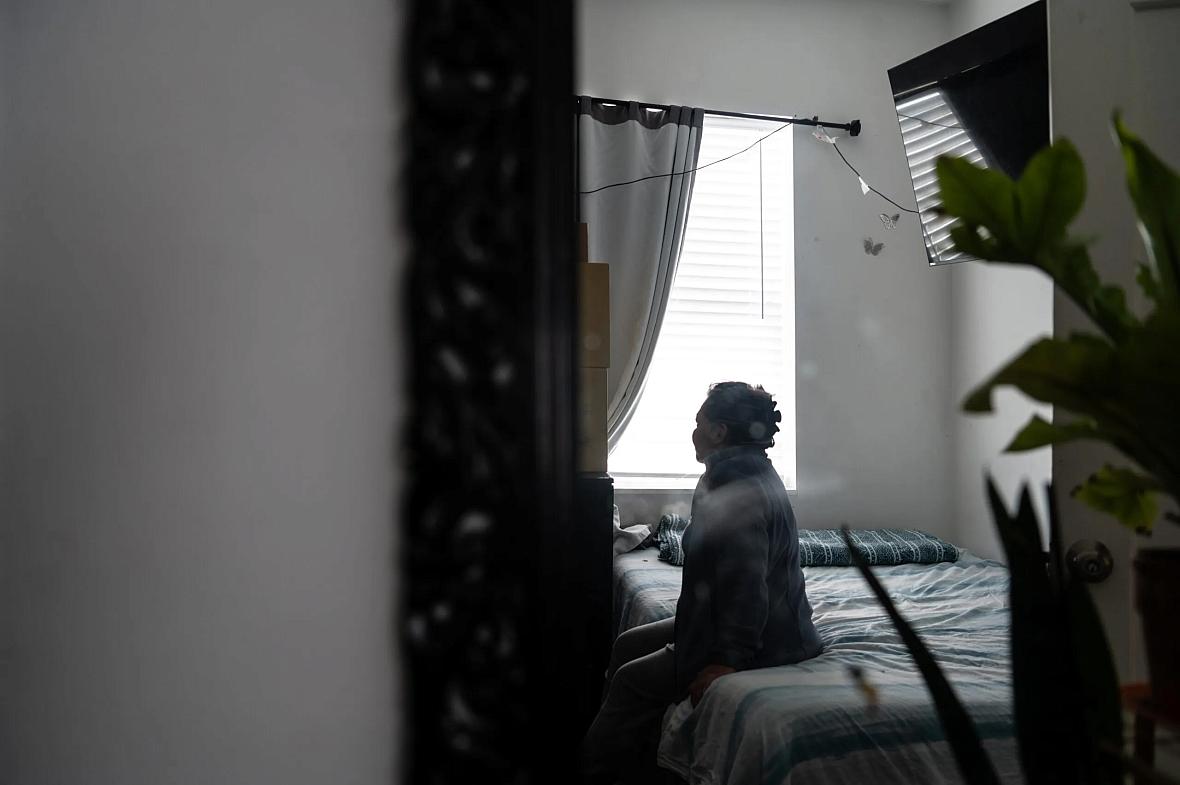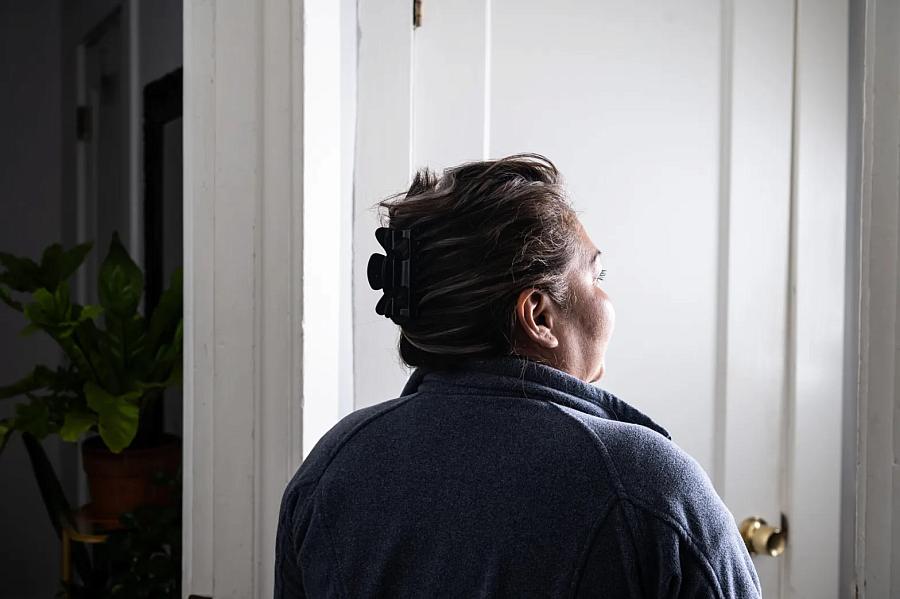With Trump’s Spending Bill, California Immigrants Fear More Healthcare Rollbacks
The story was co-published with El Tecolote as part of the 2025 Ethnic Media Collaborative, Healing California.

G.H., 51, barely survived an episode of domestic violence when she was pushed off a two story building. The Salvadoran woman says her Medi-Cal is essential for her health, and fears for her physical and emotional well-being with looming cuts. Photo: Pablo Unzueta for El Tecolote/CatchLight Local
Over the past three years, G.H., 51, says she’s spent more time inside San Francisco’s General Hospital than she has at home. In 2022, the Salvadoran woman barely survived an episode of domestic violence when she was pushed off a two-story building in Daly City. The fall, she said, shattered her ankle and permanently damaged her back and hips.
When she arrived at the hospital, G.H., who requested to be identified by the initials of her middle and last name, said her doctors enrolled her in Medi-Cal, California’s health insurance program for low-income residents. Since then, the state-funded coverage has paid for multiple surgeries, physical therapy and treatments like acupuncture to manage her injuries and chronic pain, along with counseling for the emotional trauma she still carries.
G.H.’s doctors have told her she won’t fully recover, so they’re focused on improving her mobility and quality of life. But now, G.H. worries many of these ongoing treatments might soon be out of reach. On July 4 2025, President Donald Trump signed the One Big Beautiful Bill Act (OBBBA) into law—a controversial spending bill that would cut many federal healthcare benefits for immigrants with and without legal status.
The bill would require some states, including California, to shoulder a greater share of emergency care costs for immigrants. It would also limit more immigrants’ eligibility for Medicaid (known as Medi-Cal in California) — leaving refugees, parolees and domestic violence survivors uninsured unless states decide to fund their coverage through expansion programs, like California does for undocumented residents.
“It would be terrible for all of us,” said G.H., who is undocumented but in the process of applying for a U Visa. Unable to work because of her injuries and currently supported by her children, she worries the coming changes might impact her ability to afford the medical care she needs. California, facing its own budget crisis, has already scaled back parts of its Medi-Cal expansion program.

G.H., 51, stands in a hallway in Daly City, on June 12, 2025. Photo: Pablo Unzueta for El Tecolote/CatchLight Local
“There are many people who have worked all their lives here,” she added. “Now they need medical care and they’re taking it away from them.”
Budget fixes that could cost immigrants their care
Many immigrants without permanent legal status are currently ineligible for federal healthcare benefits like Medicaid outside of emergency procedures. But over the past decade, some Democratic-led states have used their own funds to expand low- and no-cost care to cover all low-income and disabled residents, regardless of status.
California started its Medi-Cal expansion in 2016 with coverage for children under 18, eventually including immigrant adults aged 25-49 in 2024.
The state, however, underestimated how many immigrants would sign up. More than 1.6 million are currently enrolled, according to state data, costing California over $2 billion more than projected, and prompting lawmakers to backtrack on their universal health care promise.
On July 1, California legislators approved a plan to start charging $30 premiums for immigrant adults aged 19-59 enrolled in the expansion program, and to freeze new enrollment. Lawmakers added a six-month grace period for re-enrollment, and ended dental benefits for expansion recipients.
Legislators negotiated down more aggressive measures initially proposed by Governor Gavin Newsom, which included higher premiums, ending long-term care and broader enrollment freezes. However, without comprehensive federal support, including emergency room visits, another difficult budget discussion could soon be underway.
Doctors and advocates warn of a looming healthcare rollback
Many doctors and community advocates are worried that limiting access to care could negatively impact already struggling communities: from an increase in emergency room visits to aggravated chronic conditions. Some immigrants, like G.H., say they’ll be unable to afford California’s proposed premiums, leaving them uninsured, while others fear the loss of specialized care they’ve come to depend on.
“They tell us there isn’t enough money for healthcare, but there’s always money to detain and deport our communities,” said Maria Moreno, who is part of Mujeres Unidas y Activas, a Bay Area nonprofit that works on immigrant women empowerment. “That is a direct attack on working-class, immigrant, and survivor communities.”
At community clinics — where many of San Francisco’s immigrants receive care — staff worry that a reduction in revenue could limit the breadth of services they’re able to offer.
“I’m afraid of regressing,” said Juan Carlos Lozano, a family doctor at the Family Health Center in Zuckerberg San Francisco General Hospital. “We were able to make so many breakthroughs to provide health care as a right, because it is supposed to be a right. But I’m afraid in this political environment that we’re losing that aspect of humanity that we are supposed to uphold.”
Can San Francisco’s safety net absorb the blow?
San Francisco may be among the “best equipped” parts of the state to respond to these cuts because of some of the programs it already has in place, said Laurel Lucia, director of the Health Care Program at UC Berkeley’s Labor Center.
The city’s Department of Public Health (SFDPH) has run Healthy San Francisco since 2006, providing uninsured adult residents access to basic medical services within the city through income-based participant fees. The program excludes long-term care and certain surgeries, and wait times can be long, but for years, it was the only way that many immigrants could access urgent and preventative care.
On the ground, the many community clinics in the city, both independent and SFDPH run, have employed bilingual and bicultural doctors and staff for decades, building up trust with communities that might have otherwise shied away from accessing health care.
“I’ve followed some of these patients for over 15 years,” said Brad Williams-Padilla, chief medical officer at the Mission Neighborhood Health Center (MNHC), which has two independent community clinics in the city’s Latino neighborhoods. “And so there’s a deep trust, you know, that’s developed partly just by being here stably over time for a lot of time.”
Dennisse Porter, a nurse practitioner and chief associate medical officer at the MNHC’s Shotwell Clinic, said that although the center remains vulnerable to the proposed cuts — around 84% of the clinic’s patients were publicly insured last year — they’re committed to making sure everyone continues receiving care.
“We just have to change maybe the modalities of how we give services, but I don’t think it’ll impact who we’re gonna serve,” Porter said. “And it’s a challenge, right? Because when people were able to all access Medi-Cal, it was great, right? It was a great way to get people to care that needed it for a long time.”
Exactly how the city will collaborate with health providers to fund that commitment remains unclear.
In a statement to El Tecolote, SFDPH reaffirmed its commitment to provide universal healthcare access, although it has not laid out how it would absorb these potential new costs, especially given San Francisco’s own controversial efforts to balance its budget.
For older immigrants, the changes feel all too familiar
Many immigrants who have lived in San Francisco for decades remember what it was like to navigate the healthcare system without earning much nor qualifying for much government aid. For them, the added premiums and limited benefits feel like a return to the past.
When Guadalupe S. crossed the border in 1999, she could already feel a tumor above her right leg. Soon after she settled in the city, she said she headed to SF General, seeking treatment.
She didn’t know much about Medi-Cal back then, but she had heard from a friend that she could get free emergency care. After a day of waiting for a translator in the hospital though, she learned that the lump inside her wasn’t yet an emergency. It wasn’t until nine months later, she said, after the tumor grew to the size of a “large melon,” that the hospital staff told her they could remove it with surgery.

Guadalupe S., 62, who only wanted to be identified by her first name, embraces the plants at Cayuga Park in San Francisco, Calif., on June 27, 2025. Guadalupe suffers from osteoporosis in her hands, resulting in pain and a weaker grip strength. Her Medi-Cal, which she relies on, faces uncertainty with looming medical cuts. Photo: Pablo Unzueta for El Tecolote/CatchLight Local
Guadalupe S., 62, who only wanted to be identified by her first name, embraces the plants at Cayuga Park in San Francisco, Calif., on June 27, 2025. Guadalupe suffers from osteoporosis in her hands, resulting in pain and a weaker grip strength. Her Medi-Cal, which she relies on, faces uncertainty with looming medical cuts. Photo: Pablo Unzueta for El Tecolote/CatchLight Local
For a large part of the 26 years she’s spent in San Francisco, working long hours to support herself and her four children, Guadalupe said, much of her experience in the healthcare system has consisted in waiting. Without legal status, and facing a slew of medical conditions — from more tumors, to dealing with the aftermath of a Hepatitis B infection — she had to navigate the fact that she didn’t always qualify for emergency care right away. Sometimes, she was able to access surgeries earlier by participating in clinical studies, or when doctors helped her find outside funding. With the income from her jobs, she also paid small premiums to access Healthy SF, which helped cover some parts of the care she needed.
Now, at 63, and enrolled in Medi-Cal benefits, she says she’s finally finding a moment to rest. Two years ago, she stopped working to address her mental health and developing osteoporosis, and she’s spent the last two years living with her daughter, going to therapy to treat her anxiety. She visits her local clinic for preventative screenings, and to treat her brittle bones. But, depending on how the state decides to limit healthcare for immigrants like her, she says she might need to get back on her feet.
“I’ll have to look for a job again, because healthcare is so important for my wellbeing,” said the 63-year-old Mexican grandmother. “Imagine, I’ll be back in the same place as when I got here, except that working was easier before, when I was younger … Now I have a mental illness that makes it hard to know when I’ll be feeling well and when I won’t. I can’t do things the way I did before.”

This project was supported by the USC Annenberg Center for Health Journalism, and is part of “Healing California”, a yearlong reporting Ethnic Media Collaborative venture with print, online and broadcast outlets across California.
